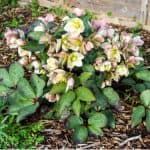Last updated on May 3rd, 2022
Our site is reader supported, this means we may earn a small commission from Amazon and other affiliates when you buy through links on our site.
Hellebore plants, commonly referred to as the Christmas rose are known for producing a great deal of colour and attractive foliage, as well as providing winter interest with flowers often appearing above the snow-covered ground. That’s how hardy they are.
There are many types of Hellebores out there that provide a range of colour options for the flowers including purples, pinks, yellows, and white. Some even have decorative markings on the inside of the flowers. Some of our personal favourites include the Helleborus niger and some of the Helleborus x hybridus varieties, these are also commonly known as Oriental hybrids.
Selecting the right variety
There are different varieties available, some of which we have already mentioned. Some are easier to grow than others and it’s important to know which one you are selecting for your garden. Most need well-drained soil to thrive, if you have this then you have gotten a head start already.
Helleborus hybridus
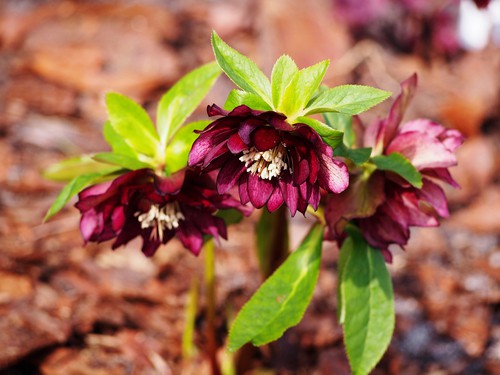
The Helleborus hybridus, sometimes known as Oriental hybrids, is one of the more popular varieties for easy maintenance because they are very easy to grow. They live for a long time and can take a lot of neglect, along with a little basic care of course. The foliage is dark green and very bold, the flower colours will vary so make sure you know what flower shape and colour you want the most.
Helleborus sternii
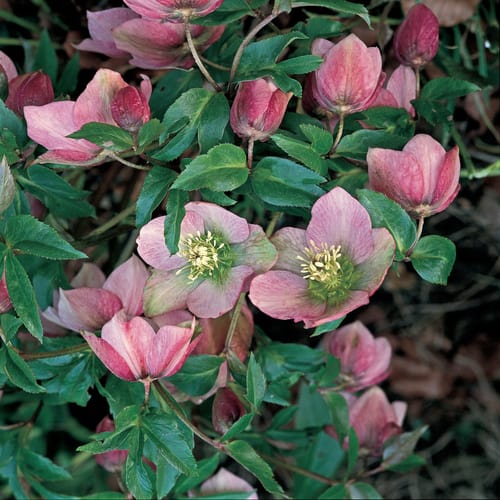
If you are looking for very attractive foliage and flowers, the Helleborus sternii is just one of many hybrids and cultivars that enjoy a lot of sun. This species of Hellebore is short-lived.
Helleborus niger
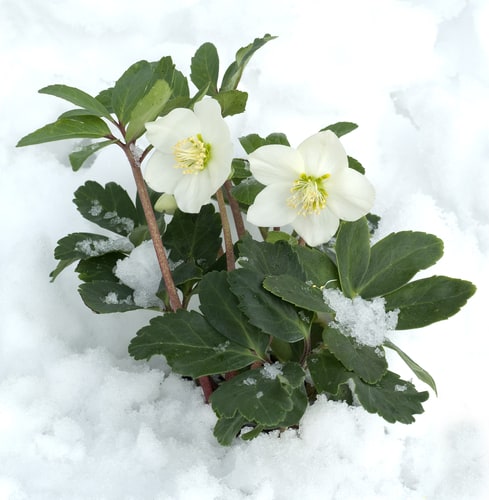
The one that most people know and love is actually the Helleborus niger. This is probably the most popular variety available, but it’s also the most difficult to grow in an outside garden because you need to make sure your garden has ample drainage throughout the winter. This can be particularly challenging in the UK if you live in an area with a lot of rain. That being said, there are many ways to improve drainage, we have covered this in this guide.
When to plant Hellebores
You should ideally plant your Christmas Rose between autumn and spring. You should be able to buy flowering plants ready for planting directly in the late spring at most well-stocked garden centres and nurseries. Failing this, many online stores also now sell them, including Amazon, which has a range of specialist growers now selling on their platform. It’s best to avoid planting them during the summer when it’s too hot but if you have no choice, just remember to keep them well-watered.
Where to plant Hellebores
Because they add a lot of visual interest in the winter and at the beginning of spring, most people like to add them to border gardens but they also grow just as happily in containers.
Make sure that you pick a position that has light shade and full sun for the majority of the day. Your soil needs to be rich with organic matter so dig in plenty of leaf mould or garden compost and have a lot of drainage. The popular Helleborus niger variety prefers a position that has more shade than it does sunlight and is very easy to grow in containers or raised planter beds.
How to Plant Hellebores
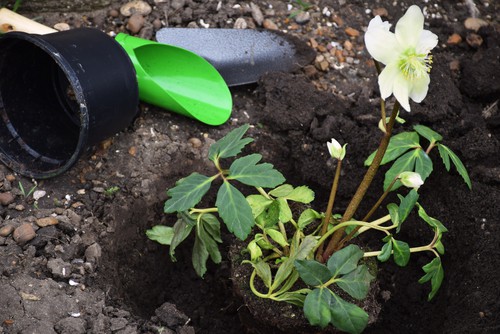
Planting
Helleborus thrive in moist soil that doesn’t get waterlogged so you have to make sure that you dig the hole and add garden compost to improve the soil condition before you plant your Hellebores. If drainage is an issue add some grit to improve the drainage beforehand too.
Make sure that when you place the plant in the hole, the top of the root ball or where the container ends is level with the surface of the soil. You don’t want to plant them too deeply because doing so can cause them to rot off.
If you are planting more than one, make sure that you plant them about 35cm apart from one another so they have plenty of room to spread.
Mulch around the base
Once you have planted them you can add mulch around the base to prevent the soil from drying out and help retain moisture which they like, it also helps to suppress weeds. Make sure that during the first season of planting you water them regularly, especially when the weather is dry to help them get established.
Growing in containers and pots
Helleborus are actually more easily grown in a container or pot because you can better protect it from too much water in the winter and provide it with the drainage it really needs. So if you do choose to grow it in a container, make sure that you give it extra protection from frost and prevent it from too much water exposure by moving it against the base of a wall or underneath some sort of cover. Just be careful not to let the soil dry out because it still needs to be kept moist.
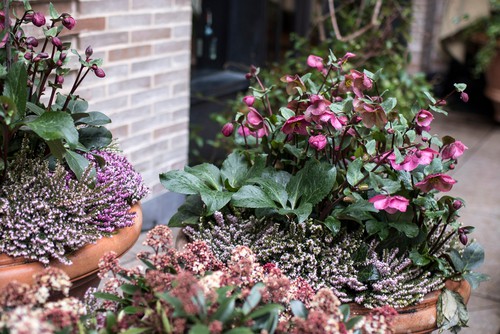
The container you choose needs to be one with ample drainage holes, and filled with good quality multi-purpose compost. John Innes soil-based compost mixed with around one-third grit is perfect because it will retain moisture while being free-draining. Make sure that you put the plant to the same level in the container as it was in its original pot and don’t plant it too deeply.
Regular Care for the first 12 months
Newly planted Helleborus it will need a lot of watering during the first season, particularly during the spring and summer. You can reduce moisture stress by adding mulch and compost around the base.
Feeding
Aside from that, if the growth is not doing as well as you would want you can add a general-purpose fertiliser. It is important that you don’t add too much fertiliser until you have verified that the problem isn’t water-based.
Winter care
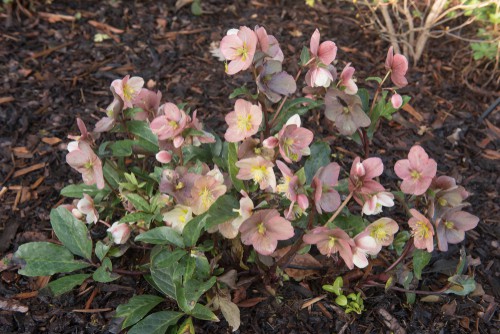
During the winter, Helleborus needs excellent drainage (as mentioned) so just make sure you give it a protected spot. Most of Hellebores can last five years or longer and you can encourage regular flowering by pruning back your plant every year.
Pruning
Helleborus plants can benefit from the removal of any damaged or disease foliage in the autumn and the removal of old flower stems at the end of spring. Other than that you don’t have to do much, which is why they are so easy to maintain.
Helleborus Problems
Aphids and leaf spot
Be on the lookout for leaf spot or aphids. These are the biggest issues you will face in terms of leaf spot and pests. Spray them with a pesticide to control any bad infestations of aphids and remove any of the leaves affected with leaf spot. You will know it’s leaf spot because it causes black spots on the leaves. Once identified, spray your Hellebore with a fungicide spray.
Helleborus Black Death
Helleborus Black Death is a much more serious condition and if you notice this on your plant, you will need to destroy it to prevent the disease from spreading to other parts of your garden. It is thought to be caused by the virus Helleborus net necrosis virus (HeNNV), where plants become stunted, deformed and marked by black streaks and netting patterns.

